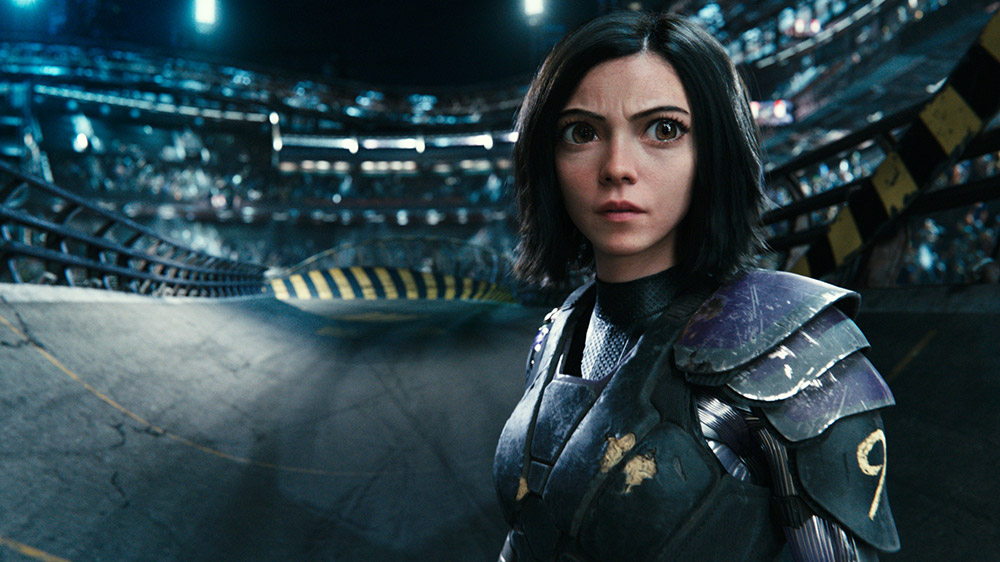Alita: Battle Angel is the ambitious Manga film adaptation from director Robert Rodriguez and executive producer James Cameron that succeeds in dazzling the senses, but suffers in its attempt to forge a deeper connection between the audience and the film’s characters.
Alita steals the show and actress Rosa Salazar puts in an incredible performance in her motion capture suit underneath a multitude of computer animated effects, however, the film is bogged down by one too many plot points, not allowing the audience to remain invested in her plight long enough before being thrust from one story arc to the next. It’s not until the very last minute of the film where you really feel attached to the character, but it may have been too little too late.
Battle Angel is set in the distant future; a place where humans and human-cyborg hybrids co-exist. Dr. Dyson Ido (Christoph Waltz), a cyborg repairman, finds an in-tact cybernetic head and neck formerly belonging to a young woman that he uses to place onto an existing robotic body. The end result – Alita. Alita struggles to find her identity early on but soon realises that she was designed for battle. She then joins a union of bounty hunters in an attempt to take down the vicious Grewishka (Jackie Earle Haley), an out-of-control, dangerous cyborg who does the evil bidding for Vector (Mahershala Ali), a villainous corporate type, he himself under the clutches of the film’s elusive big bad, Nova (actor revealed at the end of the film, won’t spoil it here).
Nova’s big diabolical scheme? To steal the physical heart from Alita’s body; a heart made from lost technology that’s way more powerful than anything out there in their present time. There’s also a love story in the mix, as Alita falls for Hugo (Keean Johnson), a young man with big aspirations to make it to Zalem, the last remaining city in the sky where all the wealthy people live, and a willingness to do anything to get there. Finally, there’s an epic, violent ‘Motorball’ game that’s all the rage as Alita enlists to try and win the race, which would give her the chance to fast-track Hugo’s efforts to meet his goals.

Beneath the surface level plot devices is a coming-of-age story for Alita that tends to work, as we see the born-again teen cyborg woman come full circle into kickass ‘battle angel’. Her creator, Ido’s story is also one that packs an emotional punch as we soon find out that there is a more personal reason for his creation of Alita.
Battle Angel is an adaptation of the first four books in the popular original Manga series (the core story based on books one and two and the ‘Motorball’ angle from books three and four) which, in hindsight, may have proved too huge a task to cover in one two-hour film, even from the likes of master filmmaker James Cameron. All the different stories cause the film to feel off-balance and had they had kept the plot tighter and less branched out, could have made for some more engaging viewing. It’s not to say the film won’t grasp you, it will, but not internally, the way it should with the deeper themes that exist beyond the film’s surface. Rather, you’ll be glued to the screen and made to marvel at the glorious visuals and frenetic action sequences the film presents, and you’ll gladly abide.

It’s here where Rodriguez and Cameron have nailed each aspect. The world they’ve created for the screen based on the source material is beautiful with articulate attention to detail. The character design is stunning and the action set-pieces are a sight to behold, perfect for viewing on the big screen. It’s violent, but not offensive; suitable enough for most ages to enjoy. Seeing the film in 3D enhances the experience (rather than detract, as is often the case), as it adds an extra depth to the already mesmerising visuals.
Even though it’s obvious the filmmakers had a franchise in the making with Alita: Battle Angel, it seems as though the film will struggle to see a sequel. It may find a decent sized audience, but it doesn’t feel like the type of movie that will make much of an impact in the super-crowded fantasy blockbuster space that we’re currently entrenched in. It’s a shame because the talent behind the scenes is of the utmost quality, yet they’ve gone too big too soon. Even though the film succeeds as pure spectacle popcorn entertainment, a more compact story could have made the opportunity for a franchise that much greater, though time will tell.
Fun Fact:
The main character, even though the film is live-action, is done with CG animation and was shot in 3-D, using the stereo imaging system that James Cameron had been developing for his documentaries.




COMMENTS